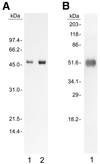Biochemical characterization of the small isoform of Drosophila melanogaster RECQ5 helicase
- PMID: 11452023
- PMCID: PMC55816
- DOI: 10.1093/nar/29.14.2986
Biochemical characterization of the small isoform of Drosophila melanogaster RECQ5 helicase
Abstract
Recently the gene encoding a member of the RecQ helicase family, RecQ5, was cloned from the fruit fly, Drosophila melanogaster [J.J.Sekelsky, M.H.Brodsky, G.M. Rubin and R.S. Hawley (1999) Nucleic Acids Res., 27, 3762-3769]. The Drosophila RecQ5 transcript is alternatively spliced, like its human counterpart, to yield three protein isoforms. Two of these isoforms are almost identical and have a predicted molecular weight of 54 kDa. The third isoform is larger and contains, in addition to the helicase domain shared by all three isoforms, a long highly charged C-terminal region. A small isoform of the Drosophila RecQ5 protein (RECQ5) has been expressed in Escherichia coli and purified. The purified protein is a single-stranded DNA-stimulated ATPase (dATPase) and a 3'-->5' DNA helicase. Hydrolysis of the nucleotide cofactor is required for unwinding activity and dATP supported the unwinding reaction better than other NTPs. The turnover number for the single-stranded DNA-stimulated dATPase activity was 1380 min(-1), approximately 1.5-fold higher than that observed for the ATPase activity (900 min(-1)). The purified protein catalyzed unwinding of partial duplex substrates up to at least 93 bp, however, unwinding of an 89 bp blunt duplex substrate was not detected.
Figures






References
-
- Karow J.K., Wu,L. and Hickson,I.D. (2000) RecQ family helicases: roles in cancer and aging. Curr. Opin. Genet. Dev., 10, 32–38. - PubMed
-
- Shen J.-C., Gray,M.D., Oshima,J., Kamath-Loeb,A.S., Fry,M. and Loeb,L.A. (1998) Werner syndrome protein I. DNA helicase and DNA exonuclease reside on the same polypeptide. J. Biol. Chem., 273, 34139–34144. - PubMed
Publication types
MeSH terms
Substances
Grants and funding
LinkOut - more resources
Full Text Sources
Molecular Biology Databases
Miscellaneous

